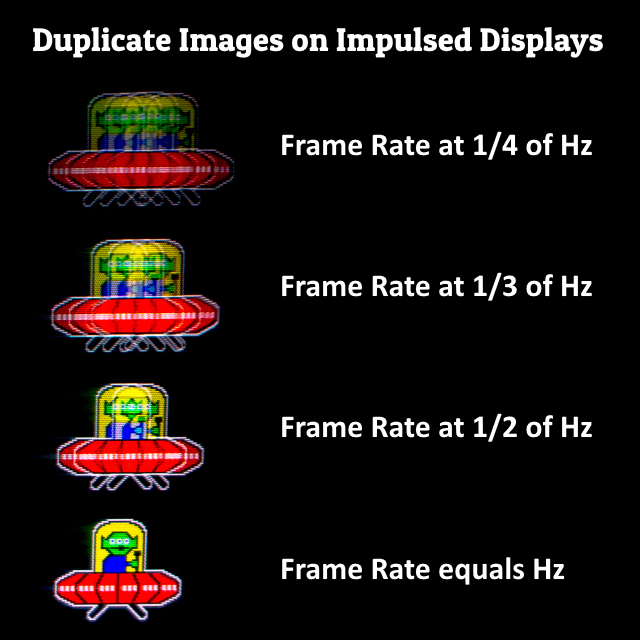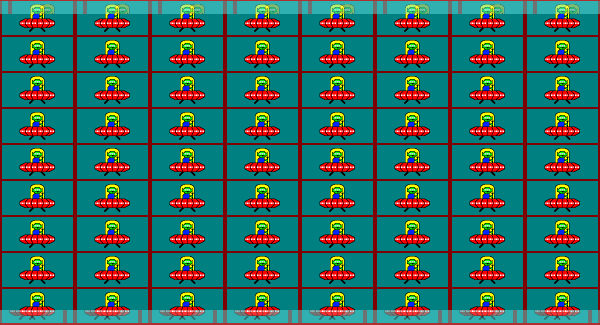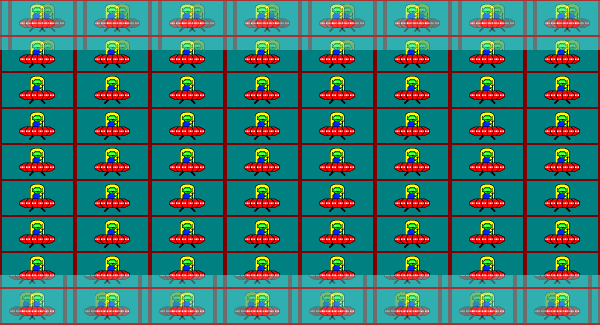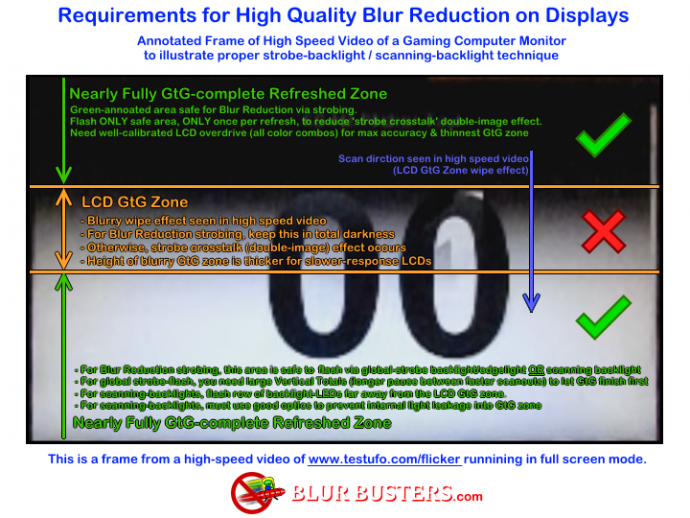ULMB: Ultra Low Motion Blur
ULMB eliminates display motion blur. For people not familiar with ULMB, see Moition Blur Reduction FAQ.
First, Fix Your Frame Rate
If you turn on the “ULMB” setting via the OSD of a 144Hz+ G-SYNC gaming monitor, you may see multiple images. Problems with ULMB duplicate images can occur if your frame rate is lower than refresh rate.
To eliminate blatant double images, make sure your frame rate is matching refresh rate when you are using ULMB. (Or if you prefer VSYNC OFF, use an overkill frame rate far exceeding refresh rate).
However, you may still notice some minor “strobe crosstalk” even during full frame rate motion. The rest of this page explains:
Understanding Strobe Crosstalk

This is more particularly acute at the top-edge and bottom-edge of the screen. This effect is more noticeable at higher ULMB refresh rates than lower ULMB refresh rates.
Strobe crosstalk has a bigger effect on the top/bottom edges of your display. Higher refresh rates can also make strobe crosstalk more visible.
LightBoost is similar to ULMB, so here is our older high speed video of LIghtBoost being accomplished via a flashing strobe backlight. This makes it easier to understand the top/bottom edge behaviors.
LCD disaplay panels are generally refreshed one row of pixels at a time. During LCD pixel transitions (Grey-to-Grey response), one part of the screen always have a superimposed double-image as the old pixel “fades” to the new pixel over a finite time period.
An LCD panel to keep refreshing even if the backlight is temporarily turned off during the refresh cycle. This can allow the slowness of the LCD pixels to be bypassed (and avoids the sample-and-hold effect that causes motion blur).
The big catch is there’s very little time between refresh cycles. This is called the “vertical blanking interval” (VBI) or “vertical synchronization” (VSYNC). It often lasts shorter than the pixel response rating (e.g. 1ms GtG for TN panels). As a result, there are incomplete pixel transitions at bottom edge, while the top edge already has begun pixel-transitions of a new refresh cycle.
The blanking interval is briefer at higher refresh rates, so there is more difficulty avoiding strobe crosstalk:
100 Hz ULMB
144 Hz ULMB
These are very approximate, and may be thinner or thicker than these simulated diagrams; but the rule of thumb is the crosstalk zone becomes thicker at higher Hz.
That’s why most monitor manufacturers disable strobing at the monitor’s highest Hz. This is why ULMB works only up to 120Hz or 144Hz on most GSYNC monitors, because manufacturers want to avoid image quality problems.
A few manufacturers (e.g. LG and ZOWIE) definitely allow you to strobe at 240 Hz, letting users decide if the increased crosstalk is worth the benefits of blur reduction. However, most just simply disallow blur reduction at higher refresh rates to prevent user complaints about strobe crosstalk.
LCD Refresh Cycles 101: A Brief Explanation
If you watch the high speed video of display blur reduction carefully, you observe that an LCD screen is “scanned” from top to bottom. An LCD refreshes the top edge first, followed by screen centre, followed by bottom edge. In the high speed video, the “GtG Zone” shows a downwards-wipe effect to replace the old image (old refresh cycle) with a new image (new refresh cycle).
This happens 120 times per second on a 120 Hertz monitor, so the refreshing happens too fast for the eye to see directly. However, the human eye can still see side effects such as motion blur or multiple-image effects.
With higher refresh rates, the “LCD GtG Zone” becomes taller because LCD pixels can’t respond faster. And the time between refresh cycles become shorter.
So more incomplete pixel transitions still remain at bottom edge, long after the top edge has already begun refreshing a new refresh cycle. So there’s never a moment where the entire screen is fully, completely, perfectly refreshed, the moment the strobe backlight is flashed.
The moment of the flash, reveals strobe crosstalk because two incomplete refresh cycles are overlapping each other for those particular pixels.
How Do I Reduce Strobe Crosstalk?
- Ensure your framerates are always running at full refresh rates.
- Reduce your “Contrast” setting. This can reduce ghosting massively.
- Reduce your ULMB refresh rate slightly. 100 Hz has less strobe crosstalk than 144 Hz.
- Enable VSYNC ON. Use HOWTO: Low-Lag VSYNC ON to reduce input lag.
- If your room is cold, warm up your LCD for 30 minutes. Frozen LCDs ghost more.
Long Detailed Article About Strobe Crosstalk
For more advanced reading, see Advanced Strobe Crosstalk FAQ.










